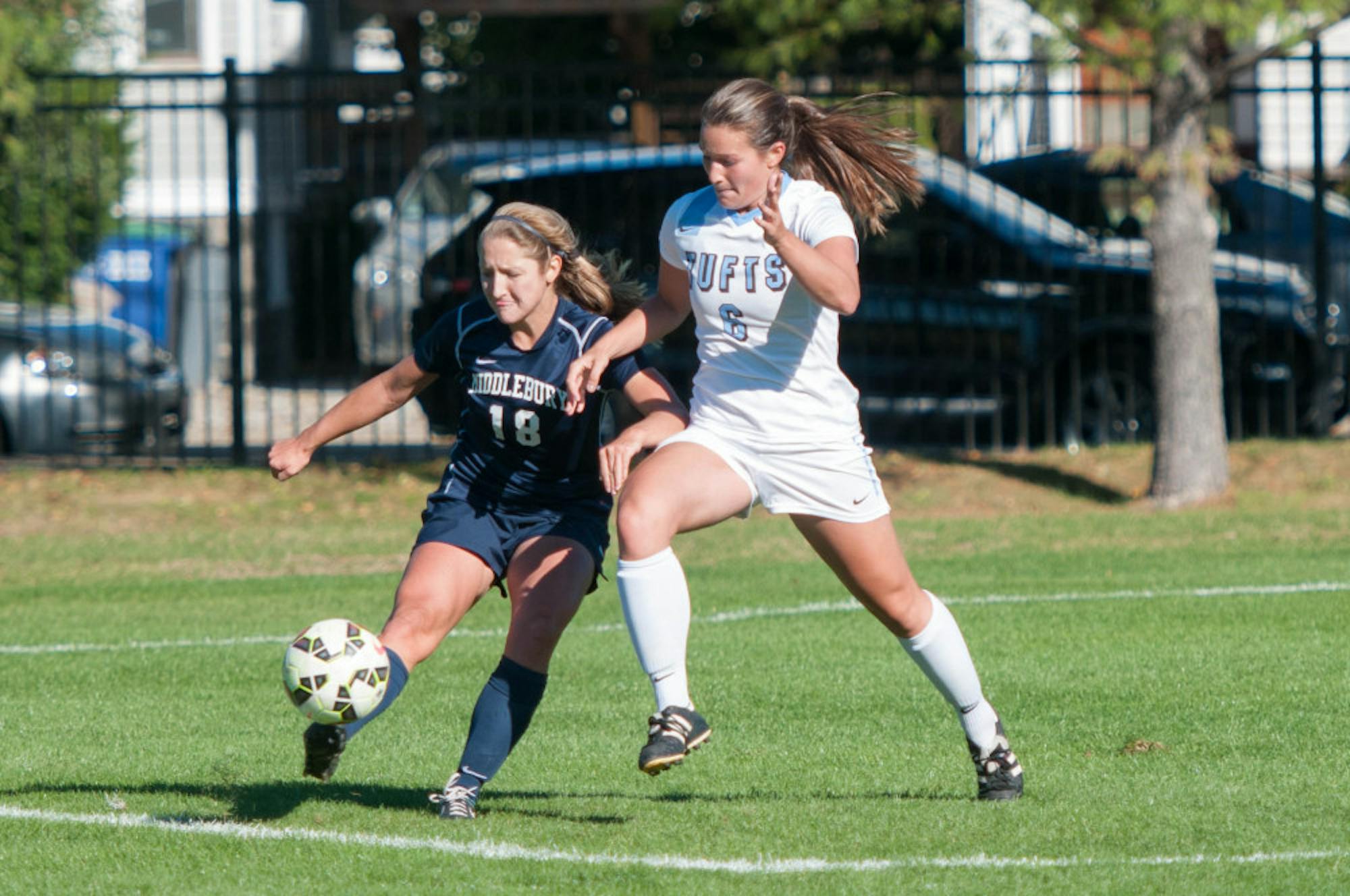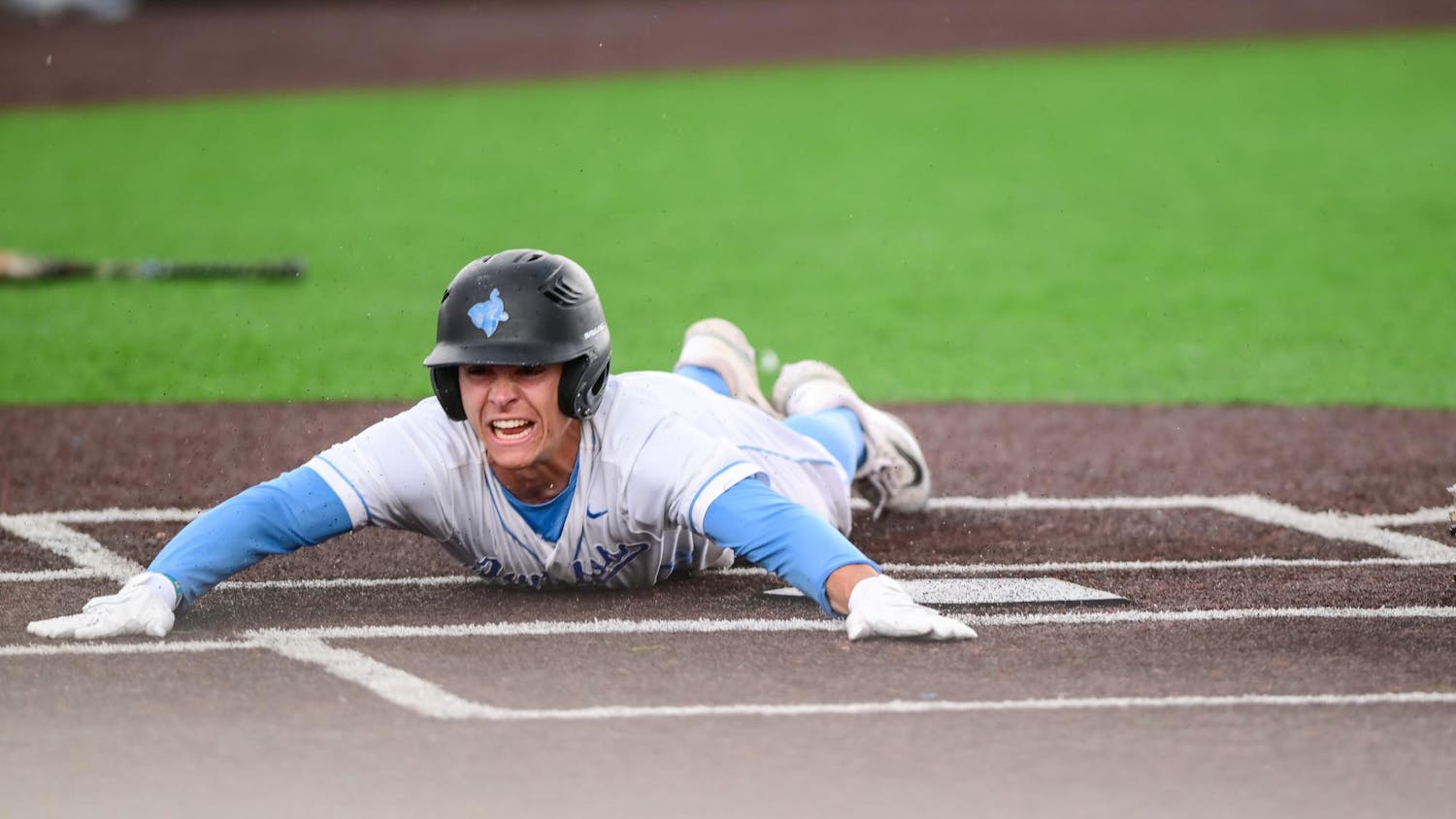For the second consecutive season, Tufts entered the NESCAC tournament seeded seventh and traveled to face second-seeded Bowdoin. For the second year in a row, the Jumbos were defeated to end their season. They finished with a record of 6-8-2 (4-5-1 within the NESCAC), scoring 14 goals over the course of the season and allowing just 18.
The season started slow and ended very much the same way but was characterized by a commendable stretch in the middle. After the first few games saw the team concede seven goals, Tufts went on a run spanning nearly a month (Sept. 29 to Nov. 20) in which it gave up just two goals and lost only one game.
With so many first-year players starting at key positions, the team took a while to start playing as a unit.
“We finally found our rhythm and began to capitalize in those [middle-of-the-season] games,” first-year goalkeeper Emily Bowers said. “We had incredible chemistry from the start, but it takes time to adjust to new players every year.”
Tufts played some of its best soccer during this period, and nowhere was it more evident than in the game against Amherst. It was the first game of a doubleheader for Amherst, who at that time held a 5-1 record and ranked No. 15 in the nation, and Tufts went into the matchup as the underdogs. The Jumbos responded well -- pressing high, something they did effectively all season long, and did not give the Lord Jeffs enough time on the ball, surprising their opponents with their intensity. A first-half goal from junior forward Jess Capone and a strong defensive unit, aided by junior Brooke Fortin at left-back, led to an uncompromising victory.
“We got a true sense of the talent that we had after this win,” Bowers, who had seven saves in the game, said. “Beating them at home 1-0 was a great feeling and helped motivate us to push ourselves even harder."
During this period of relative dominance, however, the team's offensive returns remained slim. The team averaged just less than a goal per game, and its lack of experience showed in the buildup play. The team struggled to connect good midfield possession to the final third and scoring -- a theme throughout the course of the season. The team averaged nearly 16 shots per game but had difficulty finding the back of the net.
“Partway through the season, we changed what we did on offense,” first-year midfielder Alex Aronson said. “We added in...something like guidelines for what should be done in every situation. For example, when the forward lays the ball back to the midfielders, she needs to go on a diagonal run and the opposite wing needs to loop around and look for a long pass. This helped make our offense more dynamic.”
Although these changes did lead to a better goal-scoring record in the later part of the season, matchups against division powerhouses Bowdoin and Williams proved to be too much for Tufts.
The remarkable defensive record, meanwhile, can be attributed to the experience players on the defensive line -- three juniors and one senior -- have with each other. Bowers contributed with a remarkable .824 save percentage, making 86 saves over the course of the season. The wing backs in defense also played a key role in attacking, pushing up and linking with the midfield when the wingers would cut inside, delivering crosses into the box from wide areas.
On the other hand, the lack of offensive output can perhaps be attributed to the fact that, unlike the defensive line, these players hadn't worked together as extensively. Several central midfielders and attacking players were all either new to the team or new to their position. This was a sharp contrast to other NESCAC teams, where experienced offenses were more prolific. Williams’ striker pairing of juniors Kristi Kirsche and Audrey Thomas shows a rise in number of goals scored per year playing together, and while Tufts may not rely on two main goal scorers, the more experience the team gets together will only be positive for the team.
However, with 10 first-years on the team, many of whom occupy key positions, the program looks poised for much future success. Talents like central midfielders Sarah Grubman and Emma Ranalli, winger Alessandra Sadler, Aronson and keeper Bowers will only continue to mature and grow into their game. The team graduates just three seniors: defensive leader and co-captain Nicole Campellone, striker Allie Weiller and goalkeeper Emily Morton. All three spoke highly of the class of first-years and hold high hopes for what is to come.
During the 1-1 double overtime homecoming draw against Middlebury, Sadler netted her first career goal just before halftime in front of a raucous crowd.
“During the homecoming game, we were riding our momentum a little bit,” Aronson said. “We looked really good as a team but just weren’t finding the back of the net. Coach was trying new things up front -- seeing if there were any first-years who would play striker, things like that. Luckily, it finally dropped for us in that game.”
Continuity of players and positions, real game-time experience and the ability to effectively mentor an incoming class is what will make this class of first-years truly special in the seasons to come. Beyond the 10 first-years, the core of the defense that only allowed 1.08 goals per game is returning, as well as Jumbos' leading scorer Capone.
“All the pieces are there,” Aronson said. “We just have to keep working hard in the off-season and find the back of the net. Whether that’s kicking a ball against a wall or practicing three-on-three to get comfortable with how we play together, we have to be willing to work and embrace the fact that 21 out of 24 players are returning for next season.”
Jumbos graduate just three seniors

Tufts senior forward Allie Weiller fights with a Middlebury player for possession of the ball during an Oct. 10 Homecoming game.





